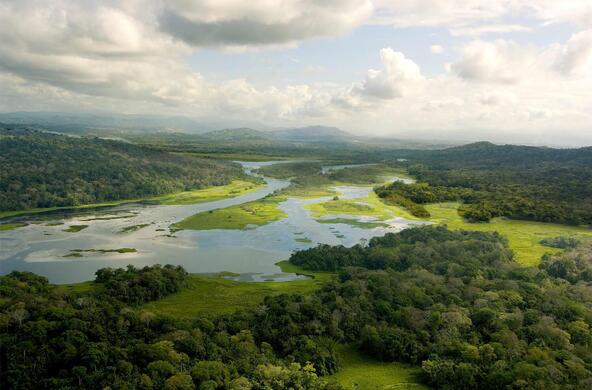When we think of tropical deforestation, we usually focus on its contributions to global climate change. Burning is associated with deforestation, converting the carbon in the trees to carbon dioxide in the atmosphere. Deforestation, largely in the tropics, is thought to contribute about 15% of the total carbon dioxide emissions to the atmosphere each year. The carbon dioxide mixes thoroughly in the atmosphere, affecting the climate from pole to pole around the Earth.
Normally tropical forests remove a lot of water from the soil and return it to the atmosphere as water vapor—a process known as transpiration. When these forests are cleared, the lower rates of transpiration may lead to permanent reductions in regional rainfall, and slow recovery of the forest.
A new study by Deborah Lawrence, an ecologist at the University of Virginia, adds yet another dimension to tropical deforestation. Normally transpiration cools the local climate. Every gram of water that evaporates carries away 540 calories (~2.26 J/g) of (latent) heat in the water vapor. Reduce the rate of transpiration, and we reduce the removal of heat from the local environment. So, areas of deforestation are likely to show greater regional warming than predicted solely from the added levels of carbon dioxide in the atmosphere. Hotter, drier conditions are likely to further slow the recovery of deforested areas. The problem is exacerbated when row crops are planted where tropical forests have been cleared. These plants have much lower rates of transpiration, and often the soil is barren for a period of the year between harvests.
A different effect is found with logging in the northern, or boreal, forest. When these areas are cleared, they leave exposed snowpack on the surface of the soil. Snow reflects a lot of incoming solar radiation—a greater albedo–effectively cooling the regional climate. Thus, the rates of regional warming from added carbon dioxide in the atmosphere may be mitigated in the spring by a greater reflectivity of the exposed, snow-covered surface.
The evaporation of water and reflectivity of the surface are known as the biophysical attributes of forests. Changes we can expect in climate will be affected by the amount of carbon dioxide in the atmosphere, and at least locally, by changes in the biophysical attributes of forests when they are cleared. There is more to a forest than the carbon.
References
Alkama, R. and A. Cescatti. 2016. Biophysical climate impacts of recent changes in global forest cover. Science 351: 600-604.
Lawrence D, M. Coe, W. Walker, L. Verchot and K. Vandecar. 2022. The Unseen Effects of Deforestation: Biophysical Effects on Climate. Front. For. Glob. Change 5:756115. doi: 10.3389/ffgc.2022.756115
Schlesinger, W.H. and S. Jasechko. 2014. Transpiration in the global water cycle. Agricultural and Forest Meteorology 189/190:115-117. http://dx.doi.org/10.1016/j.agrformet.2014.01.011
Randerson, J.T. and 13 others. 2006. The impact of boreal forest fire on climate warming. Science 314: 1130-1132.






